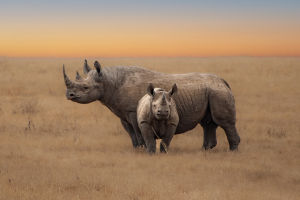Elephants, the largest land mammals on Earth, may seem alike at first glance, but African and Asian elephants have distinct physical and behavioral differences.
In this comparison, we’ll break down 11 major differences that set these two elephant species apart.
1. Geographical Range
African Elephants: Found in sub-Saharan Africa, African elephants inhabit grasslands, savannahs, and dense forests. African forest elephants live in the rainforests of West and Central Africa, while African savannah elephants roam the open woodlands and savannahs.
Asian Elephants: Asian elephants are mostly found in South and Southeast Asia, including India, Sri Lanka, Thailand, and Indonesia. Over half of all wild Asian elephants are in India.
2. Ear Size and Shape
African Elephants: Have much larger ears (up to 1.8 meters long) that are shaped like the African continent, helping to dissipate heat in the hot African climate.
Asian Elephants: Smaller, rounder ears that help them stay cool in their generally milder climate.
3. Size
African Elephants: Larger than their Asian counterparts, with males of African savannah elephants weighing up to 6,100 kilograms (13,450 pounds) and standing about 3.2 to 4 meters tall.
Asian Elephants: Smaller, with males weighing around 3,600 kilograms (7,900 pounds) and standing about 2.7 meters tall.
4. Head and Back Shape
African Elephants: Rounded heads with a concave back, dipping slightly in the middle.
Asian Elephants: Have a twin-domed head and a more rounded back compared to African elephants.
5. Trunk
African Elephants: Their trunks feature two “fingers” at the tip, which helps them grab objects with precision.
Asian Elephants: Have a single trunk ‘finger,’ making their trunks less dexterous than African elephants. They also have fewer whiskers on their trunk tips.
6. Skin
African Elephants: Known for their wrinkled skin, which helps retain water, keeping them cool in the hot African climate.
Asian Elephants: Smoother skin, with some individuals having freckles on their faces and ears, likely due to genetic factors.
7. Tusks
African Elephants: Both male and female African elephants grow large, curved tusks, which they use for digging, foraging, and self-defense.
Asian Elephants: Typically, only male Asian elephants have visible tusks, which are smaller and straighter compared to African elephants. Female tusks, when present, are often covered by the upper lip.
8. Number of Toenails
African Elephants: Three toenails on the back feet and four on the front feet.
Asian Elephants: Four toenails on the back feet and five on the front feet.
9. Social Structure
African Elephants: Have a more fixed and hierarchical family structure, led by a matriarch. They form large herds of up to 70 elephants.
Asian Elephants: Have more fluid, less hierarchical groups that consist of 5 to 15 related females. These groups may separate and reunite over time.
10. Bachelor Male Behavior
African Elephants: After reaching maturity, males leave the herd to live alone or join bachelor groups.
Asian Elephants: Males also leave their herds but tend to live more solitary lives, although small bachelor groups may form.
11. Diet
African Elephants: Prefer breaking tree saplings and eating the leaves. They also consume fruits and seeds, especially African forest elephants.
Asian Elephants: Tend to favor palm leaves, grasses, and bamboo. They also eat farm crops like rice and bananas.
Despite their differences, both species play vital roles in their ecosystems and share the same impressive intelligence and social structure.
AFRICAN ELEPHANT VS ASIAN ELEPHANT - Who Will Be The King?
Video by WildCiencias


